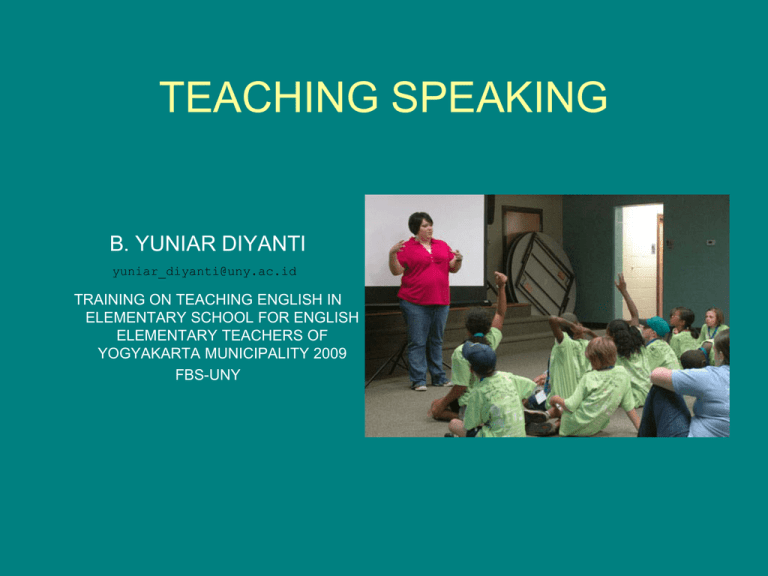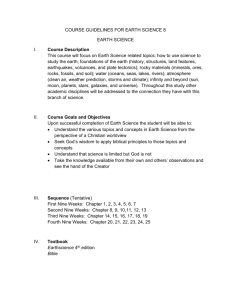TEACHING SPEAKING B. YUNIAR DIYANTI
advertisement

TEACHING SPEAKING B. YUNIAR DIYANTI yuniar_diyanti@uny.ac.id TRAINING ON TEACHING ENGLISH IN ELEMENTARY SCHOOL FOR ENGLISH ELEMENTARY TEACHERS OF YOGYAKARTA MUNICIPALITY 2009 FBS-UNY WHY? • Children in our Indonesian classes have very little opportunities in using English in communication. Therefore with this limitation each of the them should have the opportunities to speak during our lesson. If the class is large, then we have to divide the class into several groups or place the students in pairs so that they can work and help each other. • When it is speaking time, then it’s not filling in the blank activities to complete missing dialogues….. HOW? Learning through Listening • To avoid mispronunciation • With lots and lots of gesture to show what you mean • Needs several repetitions • In normal speed • PS: make sure the teacher pronounces the words correctly Establishing routines • Greetings & responding to a greeting Teacher Good morning, Good afternoon, Hello, children everybody boys and girls. Students Good morning, Good afternoon, Hello, Miss/Mrs/Mr/Ms (surname) (first name)/teacher e.g.: T : Good morning. Is today Monday? Ss: No T : Or maybe Tuesday? Or Sunday? Ss: No T : oh I wish it was Sunday. Ok, what day is today? Ss: Thursday. T : Yes, Thursday. Good. it • Short instruction: Sit down Be quiet, please. Stand up, please. Make a line/two lines/stand in two/three lines Practice: list as many instruction as you can, and show your friends how you would teach them. Using English in the way as caretaker talks • Both mother and teacher talk a lot more than the children do. e.g. T: Take off your shoes. Yes, your shoes (showing her own shoes). S: sus…sus T: Yes, shoes. • They provide a secure an supportive environment which gives the children the confidence to try out the language. e.g. (after listening to a story, the teacher and students discuss what happened in the story) T: She brings what? She brings? She brings? S: Candies.. T: Yes, candies. Great. Encouraging all the efforts children make to speak English. T: How do you say this in English? (holding a card) S: … T: Trou….trou… S: Trousers T: Yes, trousers. Good. S1: What time is it? S2: It’s nine…it’s past….(longer pause) T : Go on…What time is it? Started by a quarter.. S2: It’s a quarter…quarter past….. S3: past nine (his friend whispered) S2: It’s a …quarter…past…nine T : Great job! Listening carefully when the children speak and not interrupting to correct small errors T: And on Monday, what did he eat? S: He eated an apple. T: You mean he ate an apple. S: Yes T: Now, what time is it? S: It’s ten past nine o’clock. T: Yes, it’s ten past NINE. Without o’clock. S: It’s ten past nine. Introducing new vocabularies or expressions • Encourage students to repeat the new items • Use pictures, sounds, touch and feel materials, puppets, to support meaning • Use gestures, movement, and actions • Get children to color pictures of the new things they can name • Repeat new words as often as possible and use them and context. • Others? Getting children to speak • • • • • Games: surveying games, bandit and sheriff, shopping games, … Drilling: standing in circles then throw the ball to question-answer each other, using pictures (from books or cards), ask and answer questions in pairs/groups, telephone game Singing: We’re table number one, The finger song, Can I have a pen? Chanting: What time is it?, Telling/retelling stories





